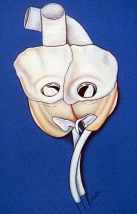This device is described here for historical purposes. It is no longer in use.
On April 4, 1969, Dr. Denton A. Cooley performed the first total artificial heart implant in the world. The device, developed by Dr. Domingo Liotta, was implanted in a 47-year-old patient with severe heart failure. The Liotta heart supported the patient for nearly three days, at which time a donor heart was found for transplantation. This experience showed doctors that patients could be "bridged" to transplantation, meaning that mechanical circulatory support systems could be used to keep a patient alive until a donor heart is found.
 The Pump
The Pump
The Liotta total artificial heart was an air-driven (pneumatic), double-ventricle pump. Wada-Cutter hingeless valves controlled the flow of blood through the inflow and outflow areas of the pump. The two pump chambers (the "ventricles"), the cuff-shaped inflow tracts (the "atria"), and the outflow tracts were lined with a special fabric that promoted the formation of a smooth cellular surface. The flexible inflow and outflow tracts were made of Dacron fabric, and the pump chambers were made of Dacron™ fabric and Silastic™ plastic.
The Console
The pumps were connected to the external power unit with Silastic tubing covered by Dacron fabric. The console, also a major engineering accomplishment at the time, was about the size of a large household washing machine. Two pneumatic power units generated the pumping and vacuum actions needed to move blood through the artificial heart. The complex control panel included numerous switches and knobs used to adjust pumping rate and pumping pressure.
For more information, you can read an article entitled, "Orthotopic Cardiac Prosthesis for Two-Staged Cardiac Replacement," which appears in Volume 24 (1969) of the American Journal of Cardiology (pp. 723-730).
February 21, 2011
Smithsonian Honors First Artificial Heart On Valentine's Day
Smithsonian celebrated Valentine's Day in a very unique and remarkable way. They used it as an opportunity to honor the very first artificial heart, the Liotta-Cooley Artificial Heart.



